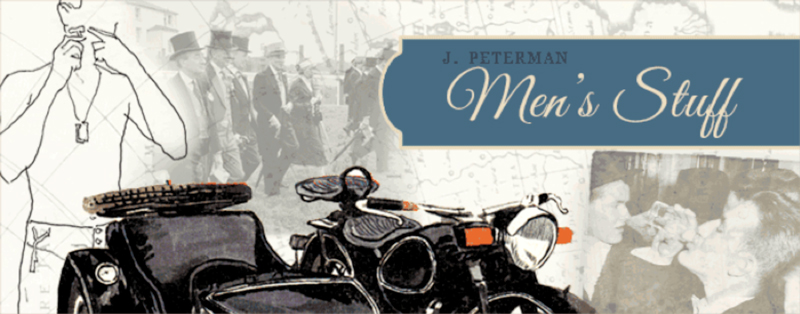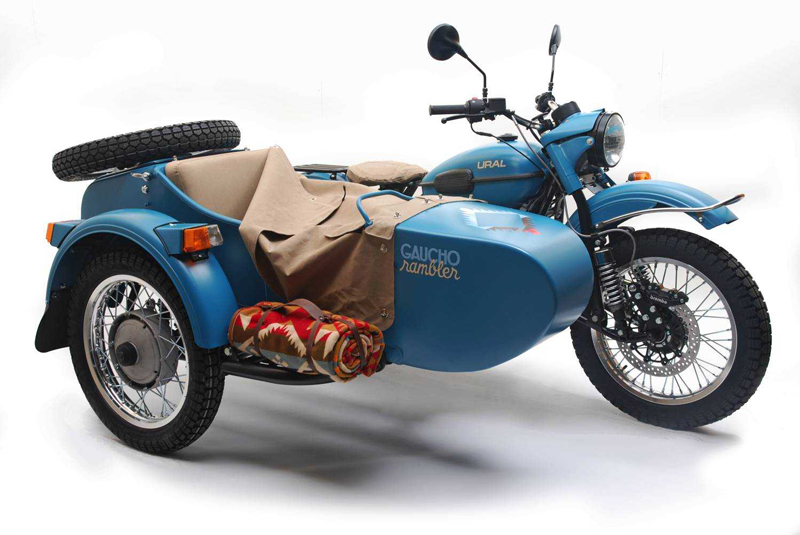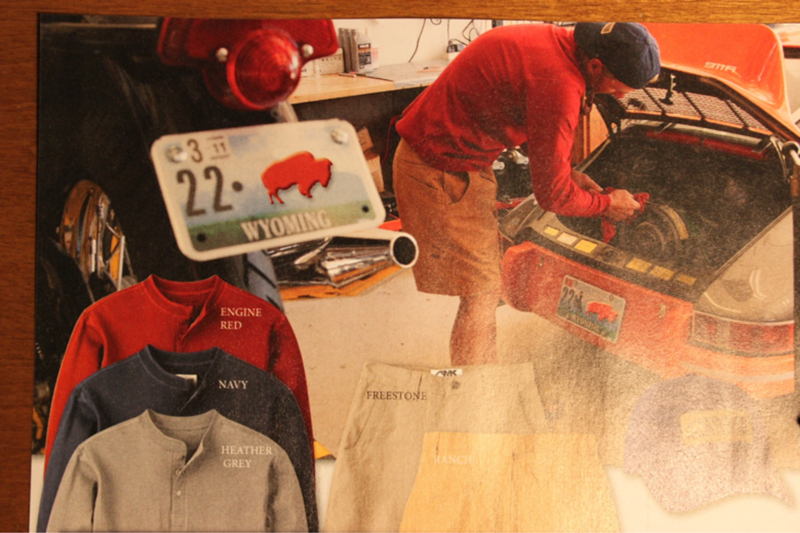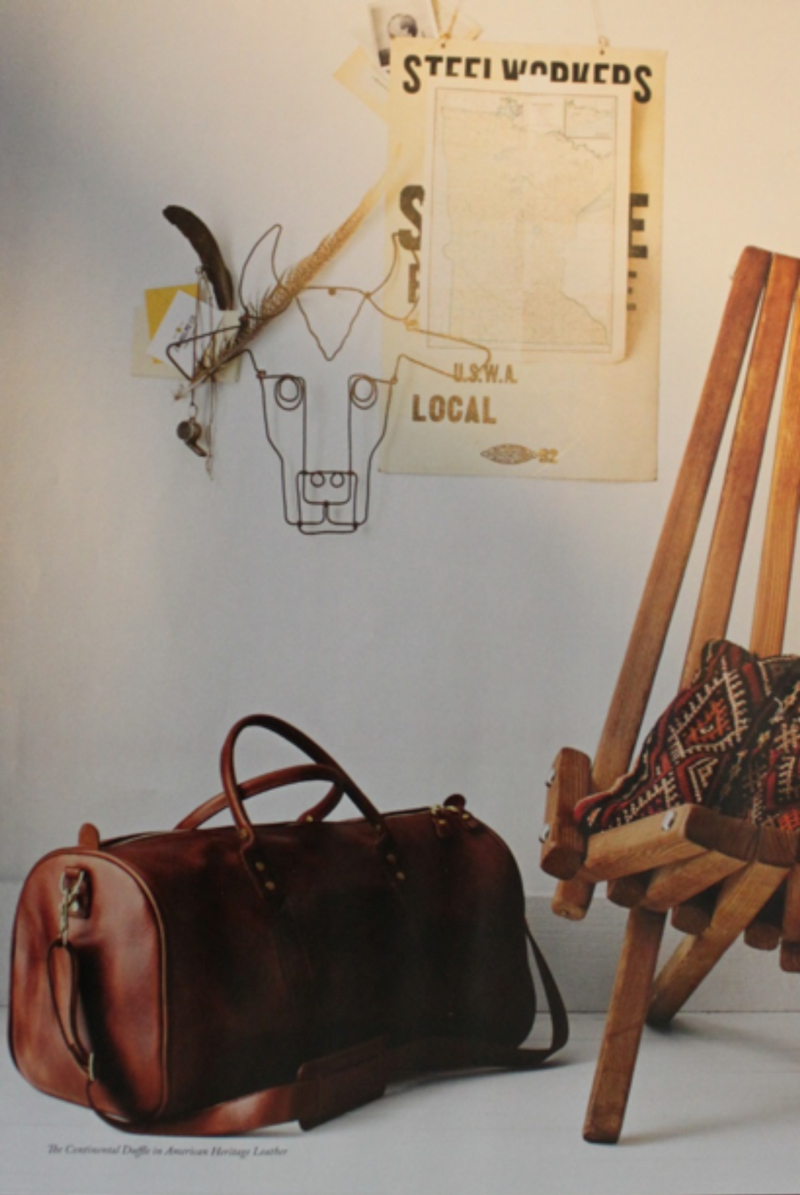It is no longer necessary, I think, to make the argument that meaning is conventional or that objects in the world—guns, human bodies, or, of course, motorcycles—can be made to mean almost anything. It is also generally accepted that meaning is tied to symbolic communities so that there can be multiple meanings for any given thing and those meanings will be braided into networks of meaning within particular ways of life. Symbolic communities and ways of life, however, exist in the tension between the lived experience of their members and the demands of the culture industry. The culture industries, and advertising in particular, have been said to take the fears and dreams of people in order to sell them back as products. In this paper, I will be looking at the way motorcycles have been embedded in a network of masculine symbols in order to reach an affluent male audience. My focus is on mail order catalogs aimed at upper-middle class men.

The J. Peterman catalog copy above illustrates the effort to weave images together to create meaning and meaningful lifestyles. The images do not have to fit together in any logical way in order to make advertising sense. Harley-Davidson riders, with some help from the Company, can seamlessly present themselves as patriotic cowboy criminals, and Jonathan Boorstein of the U.K.’s Riders Digest shows how the Pendleton Woolen Mills merges Navaho blankets, Russian copies of German motorcycles, and Argentinian gauchos. Together these become a symbolic montage that can “evoke a mood or tone of the allure of the wide open road and wide open spaces”:

In the J. Peterman catalog graphic we have a soldier shaving while wearing some sort of vintage underpants, what looks like a mid-sixties BMW, and faint photos from the 1930s—one of middle-aged (English?) men in top hats and walking sticks and the other of younger men drinking. (The only thing I believe J. Peterman sells are the vintage military underpants; every man’s dream.) Reading from left to right, as we tend to do, we begin with two powerful masculine symbols—shaving and dog tags—before swooping across elegant men’s fashion, the motorcycle, and partying. What is all of this? It’s “men’s stuff.” The stuff that men have. Or want to have. Or should have. Or, importantly, think we used to have.
There is a strong sense of nostalgia in these catalogs. The motorcycle used is never a BMW S1000RR or a Ducati Panigale R—slick, modern, plastic, and technologically advanced—but always something vaguely vintage, strongly mechanical, and generally black. Thumbing through the J. Peterman catalog one could be forgiven for thinking that perhaps the Depression and Second World War were the best times to be alive and that a really good motorcycle is one that sprays oil on your ankles.
Nostalgia is an element in almost all of these affluent catalogs. None of the vehicles are contemporary: the “SUVs” are vintage Land Rovers or Land Cruisers, the vans are 1960s VWs, the boats are made of wood, the airplanes are from the 1940s. The past, as Margaret MacMillan says of history, offers “simplicity when the present seems bewildering and chaotic.”[1] It is easy to conclude that the yearning is for an earlier time and a lot of the symbols allow people to escape—to ride, fly, sail, hike, or drive to a place where there are no obligations and men can smoke cigars on large porches over-looking placid lakes. So, the motorcycles in the ads do not represent motorcycles as much as they signify a life more meaningful—and certainly more pleasant—than that lived by most American men.
And it is about men. There are not a lot of women in these catalogs; they are not selling sex appeal. The boats, motorcycles, planes, and cars are masculine symbols. Just as nostalgia is a way of simplifying the world, so is excluding any hint of occupations, relationships, or families. Freedom from the obligations of modern adulthood is a good marketing strategy if modern adulthood creates identifiable dissatisfactions. What is interesting is that these catalogs are aimed at men who are probably among society’s more successful individuals—at least financially, given the prices of the goods that are hawked. A great way to escape is to throw your gear into a $1,500 leather duffle from The Field or the $690 backpack from J.W. Hulme: no one said the simple life was cheap.

Blurry in the original, possibly to capture the vibration of a Royal Enfield on a dirt road.
When symbolic meaning is disconnected from functional purpose, it needs to be integrated into some web of significance in order to avoid complete collapse. Symbolic meaning is socially created and maintained in a bootstrap sort of way—the notions of masculinity, motorcycles, and freedom define each other; one important aspect of being a man is independence, which is exemplified by the use of motorcycles. The webs become tremendously complicated and are continuously expanded with new experiences and efforts at product identification.
I am not sure why I started receiving all the catalogs that I do but I think it is because I once ordered a jacket from Filson. Filson specializes in made-in-America wool products based on clothing worn by prospectors and lumberjacks in the early 20th century. Now I receive about a dozen catalogs on a regular basis—how they can afford to do this is beyond me—and a number of others sporadically. These catalogs are designed to reach middle-aged, upper-middle class white men. The dominant themes tend to be adventure and affluence—The Field suggests a form of camping that costs $1,275 per night for a tent and $2,500 for a “wilderness estate,” but the more common image is of a rougher sort of adventure. Because the mailing lists of each of these companies piggyback on the lists of catalogs believed to reach a similar market, it is not surprising that they use the same symbolic clusters. Occasionally, catalogs from outside of this cluster arrive—these tend to display expensive clothing in luxurious settings like country clubs and mansions rather than the outdoors or, if it is the outdoors, it involves skeet shooting on private estates in Italy.[2] Marketing affluence as affluence is not my concern here—rather it is marketing affluence as an ironic type of anti-affluence.
The theme that interests me is the commercial symbolism of work, specifically working class skilled or semi-skilled manual labor. The J.L. Powell catalog has shifted over the years from generally rugged rural lifestyles, to vintage airplanes, motorcycles, to their current focus on handmade wooden boats. Their catalogs have featured models repairing every type of vintage machine — windmills, airplanes, cars and trucks, and even doing a little blacksmithing—although they now seem to be pulling away from this. Their catalogs currently imply rather than depict work: their $198 boatyard work pants are built to take on “tough places,” like “tool-infested workshops” which are not shown. It is said of another pair of pants that, “Winterizing the cabin, tinkering on the truck, and general puttering around the back 40 are much easier when you have the right tools at hand.” A $228 cashmere sweater is shown thrown casually on a workbench covered with blueprints for a boat, which in turn is covered with wood shavings, a chisel, and a glass of whiskey. A “Bush Pilot” jacket sold in an earlier catalog is described this way:
Somewhere there is a man staring at balance sheets in a climate controlled, glass-enclosed office tower. Somewhere else, well north of the 45th parallel, there’s a man navigating strong winds in a DeHavilland Beaver—not so climate controlled. While this jacket could find its way into the heart of either, it would certainly have a reserved spot in the heart of (the) latter.
We are in the office tower and so can afford to pay almost $400 for a jacket that looks like it was purchased at Sears, but where we really want to be—where our hearts are and where we belong—is somewhere north of the 45th parallel (less romantically known as the Montana-Wyoming border) struggling to stay alive so that we can deliver needed supplies to some isolated group or however one’s personal fantasy plays out. One of my favorites in this genre is the copy used for a linen shirt:
A three day beard. A cell phone tossed out the passenger-side window about 400 miles back. A voice hoarse from yelling at the craps table in a low-rent casino the night before. We can dream can’t we. If you do pull off such an escape, here’s one piece of clothing you should bring with you. Our linen Jac-shirt…
In the Mountain Khakis catalog, the utility pants are defined by adventure, rugged and tough, and “perform best in adverse conditions, yet clean up handsomely for real-life calls of duty.” Mountain Khakis are built for the American way of life. You could use them, that is, if your DeHavilland Beaver crashes in the mountains, but are much more likely to have “real-life calls of duty” that involve the barbecue or mowing the lawn.
This tension runs through all the catalogs. We are successful, but how did this happen to us? Why are we tethered with these cell phones? How did we end up looking at spreadsheets? Or writing code for self-parking cars? Or grading endless freshman essays? Where is my DeHavilland, my Norton Commando, my Land Cruiser, and my handmade boat?
Part of this, of course, is simply the on-going shock of adulthood, but there seems to be an underlying sense of loss or meaninglessness. When Karl Marx wrote about alienation he meant that the rationalization and de-skilling of production separated workers from the things they produced, as if the transformation of craftsmen into factory workers was complete and absolute. But factory workers still make things in a sense that the vast majority of people in a modern economy do not. I think this is the fear and the loss at which the advertisers in this niche are aiming.

Selling Sweatshirts in Montana Khakis
Marx considered this sense of loss—this distress, to use his word—in terms of religion rather than advertising in his famous reference to the “opium of the masses.” Paraphrasing Marx, we can say that the sense of loss “is at the same time the expression of real loss and the protest against real loss. Advertising is the sigh of the oppressed creature, the heart of a heartless world, just as it is the spirit of a spiritless situation. It is the opium of the people.” As with religion, salvation is a recapturing of a perfect past. These catalogs emphasize the kind of work done in the past: Filson’s lumberjacks, Cooper Jones’ artists, Peterman’s soldiers. There are no programmers here and not even Mad Men, but instead solitary men carefully constructing things of wood, leather, and steal. Salvation lies not so much in what a man can do as in when he can live.

Craftsmen, of course, better symbolize the meeting of mind and hand than do factory workers, which the customer base for these catalogs have been socialized into believing requires only bovine-like dullness. So, the Mountain Khaki catalog scatters images of American craftsman throughout their catalog while selling clothes made in nameless third-world nations:[3] Bill Royal, we are told, makes belt buckles, as does John Frechette, while Norm Larson makes knives. The catalog for Bills Khakis, is called “A Production Line Manual.” The luxury luggage company J.W. Hulme Co. mines a similar vein using the very Mitt Romney tag line “We are makers.” (They do, in fact, make rather than import their products, as does Bills.) Other “makers” are shown in the Hulme catalog; American glass blowers, designers, and songwriters are pictured using J.W. Hulme products, and an old steel workers union picket sign is used as a backdrop in one of the photos.
Oddly, the J.W. Hulme workers themselves are not depicted as makers; the makers portrayed are all small business owners or artists, rather than employees. This fits the middle-class bias in these catalogs. The Cooper Jones catalog has the models posing as artists with paintbrushes and stretched canvases casually strewn about; they too are makers. The 32 Bar Blues catalog, which appears to be a hipster tutorial for the learning impaired, implies that we could be a creative part of the music scene if only our shirts were shapeless enough.
No one dreams of working on the Ford assembly line. At least no one on any of these mailing lists. They may however dream of fixing up an old Mustang, getting that Triumph they dreamed of in high school, dusting off the guitar in the back of the coat closet, or building a cabin in the woods, of clay and wattles made. Dirty fingernails and muscles tired from work, a simple life with a good single malt scotch at the end of the day. If you have these dreams—man! do we have a pair of pants you’d like! And if you have the pants, you’re halfway there, halfway to Innisfree.
And this brings us back to the symbolic use of motorcycles. Or, perhaps, more broadly, to the way that symbolic meaning, cut loose from the pragmatic functions of life, can survive only through attachment to other symbols. “Motorcycles are like…” A long pause. “Like freedom,” said the husband of a friend of mine over dinner. He has never owned a motorcycle, but longs for one. He reminded me of the men who inevitably drift over to my campsite when I am on long motorcycle trips; they used to have a bike or almost had one or knew someone whose uncle had one, but they can’t have one now . . . and with this is a vague wave at their campsite with the children and the attractive wife who nods and smiles as I follow his gesture. Wistful more than regretful these campers, but the immense practical freedom cars offer pales next to the symbolic freedom of motorcycles; my friend’s Lexus symbolized only affluence and stability.
The catalogs I examined used vintage machinery to represent a life that could be controlled. Bob Dixon, writing in a Rohan Designs catalog, claims that “A modern vehicle can have reliability on its side but the downside is they can rarely be fixed at the side of a road if something goes wrong, especially if it’s an electronic failure. By contrast the average classic bike can usually be fixed using nothing more than a Swiss Army knife, a pair of ladies tights and a tin of WD40.” That vehicular simplicity extends to the romantic ideal of the single craftsman, of the ability to hit the road with very little, and of activities with clear outcomes.
Motorcycles are the opposite of cell phones. They disconnect us from popular culture—the vast majority of riders are not listening to music or talking on the phone, and their passengers are certainly not watching movies . . . and no one is drinking a pumpkin macchiato from Starbucks. And once mass commercial culture is removed, we are inching into the past, falling back on an idealized version of self-reliance and community that pulls strongly in a society in which the economy precludes self-reliance and the ideology of individualism rejects community.
Haideh Moghissi writes that religious “fundamentalism is ‘an attitude about time’. It proposes ‘an ideal past, initial conditions’ or ‘golden age’ which contrasts the present and can be retrieved, either by going back to an originating text or ‘by the reformation of the society’ according to models seen to be copies of an idealized past.”[4] These catalogs make a similar promise using vintage motorcycles and workmen’s pants rather than originating texts; you may not be able to transform society, but you can create your own private time machine.
This rejection of the modern society that we embrace is not simply about regrets of baby boomers—the catalogs aim at a broader demographic than that. It is also part of our larger culture—the fundamentalism that runs so powerfully through our society is generally seen as a rejection of modernism. But so, perhaps, are the hipsters’ flannel shirts and café racers, the middle-class appropriation of tattoos, the American obsession with pickup trucks, and possibly even our national insistence on owning weapons.
Motorcycles are a small part of this symbolic dissatisfaction, interchangeable in many ways with wooden canoes or hand tools, leather flight jackets or canvas suitcases. It seems these symbols are used to take commercial advantage of a deep dissatisfaction with consumer society.
Notes
[1] MacMillan, page 15.
[2] The Peter Miller, Kevin’s, and Beretta catalogs are in this category. Possibly the 1816 catalog from Remington Arms as well.
[3] In most catalogs, items are made in either name-worthy or nameless countries. In the J. Peterman catalog, for example, items made in Peru, India, Italy, the Dominican Republic, Germany, Canada, Portugal, and Mexico are labeled as such while anything else made outside the USA is simply described as “imported.” “Imported” appears to mean “you don’t want to know.”
[4] Moghissi, page 68. Moghissi is writing about Islamic fundamentalism.
Works Cited
MacMillan, Margaret. Dangerous Games: The Uses and Abuses of History. New York: The Modern Library, 2009.
Moghissi, Haideh. Feminism and Islamic Fundamentalism: The Limits of Postmodern Analysis. London: Zed Books, 1999.
John Sumser is a sociologist and a professor in the Communications Studies Department at California State University, Stanislaus. His main ride is a Triumph Street Triple, but he is building a Honda CB160 racer and looking longingly at a Moto Guzzi Griso.



My critique, beside the simple fact that I loved your piece and shared it widely, may have limited validity, depending on the intended audience. Maybe it says something about my friends (and thereby, me), but I think your opening paragraph obfuscates the significant theme of your piece.
A larger audience, if so desired, might better be drawn in to your postulation if you simply reversed the order of sentences and started with: “The culture industries, and advertising in particular, have been said to take the fears and dreams of people in order to sell them back…” Those last three sentences might “hook” more fish.
If this seems petty to you then it is. I offer my personal observation only as just that. I applaud your thinking and writing and believe (and hope) you will reach a larger audience. IJMS is too small a pond for your ideas and observations to swim, albeit an interesting aquarium of the intellectual side of motorcycle passion. Thank you for the work you put into this contribution. I hope to see more of your writing.
Not petty at all. I very much appreciate your comments and will reconsider the opening paragraph.
I’ve enjoyed sharing this article and quoting from it so much that I got curious about you and Google led me into the rabbit hole of “A Land without Time”, a wonderfully ironic nostalgia of an Afghanistan that no longer exists. Are you that Peace Corps volunteer and author? I can’t tell you how much I enjoyed that piece of writing, as well, and more IJMS readers need to know of its’ availability through Amazon. Is there more of your writing out there to discover? I’m chagrined that I even made a suggestion of improvement to a writer of your caliber. Please contribute again.
Yes, I am that volunteer. I have two novels as e-books on Kindle/Amazon. “Local Knowledge” and “Liberation” are the titles. Local Knowledge is about a motorcyclist (sort of). I have some academic stuff, too, but that may not interest you.
Oh, and thank you for the very nice comments!
Gostei muito da comparação que fez com a prisão que o celular nos oferece em relação à liberdade da moto. Poucos são os motociclistas que gostam de ouvir som nas viagens. Isso merece uma reflexão maior.